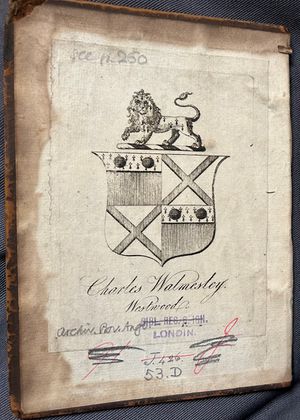Charles Walmesley 1722-1796
Charles WALMESLEY 1722-1797
Biographical Note
Born in Wigan, the seventh son of John Walmesley of Westwood House, Lancashire and his wife, Mary Greave. He was educated at the English Benedictine college of St Gregory at Douai, and the English Benedictine monastery of St Edmund in Paris. Professed as a Benedictine monk on the 29 September 1739. MA Sorbonne 1742, licentiate in theology 1750, then DD. He was Prior at St Marcel, Chalons-sur-Marne, 1749-1753, founding a literary and scientific society for the community and lay associates, and was further occupied with his own mathematical pursuits. Walmesley was in Rome from 1754 as the Procurator General of the English Benedictine Congregation, and while there visited Mount Etna to conduct scientific investigations. He became coadjutor to the Vicar Apostolic of the western district of England in 1756, and was consecrated Bishop of Rama in 1756. He became Vicar Apostolic in 1770. His scientific and mathematical studies continued throughout this time, and in 1750 Walmesley became a fellow of both the Royal Society of Berlin and the Royal Society of London. He was involved in the discussions and studies leading to the adoption of the Gregorian Calendar. He published many scientific and mathematical studies throughout the 1750s and 1760s but later turned his back on this work. Later publications were historical and theological, most notably Church History published in 1771, under the pseudonym Signor Pastorini, which predicted the destruction of protestant churches by the year 1825. Walmesley consecrated John Carroll in the Weld Chapel at Lulworth in 1790, and is thus regarded as the ancestor of the American Catholic hierarchy. He died in Bath and was buried in Bristol, in 1906 his remains were moved to Downside Abbey, Bath.
Books
Walmesley appears to have built up a large library and a considerable archive of letters and papers. Presumably in the first part of his life he owned books on scientific and mathematical themes, but much of his library was destroyed during the Gordon Riots of June 1780, when the newly built Catholic chapel in St. James's Parade, Bath, was burned to the ground, as well as the presbytery in Bell-Tree Lane, where Walmesley lived. Walmesley's archive and his manuscripts were destroyed along with the diocesan registers and archives. However at least some of his books survived. An inventory of his goods compiled in 1781 lists ‘Many books, Papers’, but the only books specified are two volumes of the Sainte Bible in quarto, with other volumes of the original 13 burnt in the riot, and a Dictionnaire Ecclesiastique in folio. The inventory also mentions at least two bookcases, one, of mahogany, in the parlour, so Walmesley must have had books to put in them even just one year after the fire. The inventory is printed in Williams, Bath and Rome pp 97-98. Examples of Walmesley’s surviving books include the Regulae Societatis Iesu printed in Antwerp in 1635 (British Jesuit Archives ALBSI/A/676), Jean Cabusset’s Juris canonici theoria et praxis printed in Lyon in 1685 (The Heythrop Library BV205 CAB 1685), and James Gordon Huntley’s A summe of controversies printed in St Omers in 1618, now at Downside Abbey Library.
Characteristic Markings
Walmesley used a heraldic bookplate which included his name and the word ‘Westwood’, the name of the house he grew up in. He also inscribed his name on the title pages, often with ‘Chas:’ on one side of the page and ‘Walmesley’ on the other.
Sources
- Scott, Geoffrey. "Walmesley, Charles (1722–1797), vicar apostolic of the western district and mathematician." Oxford Dictionary of National Biography.
- Scott, Geoffrey, 'The early career of Bishop Charles Walmesley OSB, DD, FRS, 1722-1797’, Downside Review 115 1997. 249-270.
- Williams, J. Anthony, Bath and Rome: The living link. Catholicism in Bath from 1559 to the present day. 1963.
- Bishop Charles Walmesley OSB - Downside Abbey Library blog post

